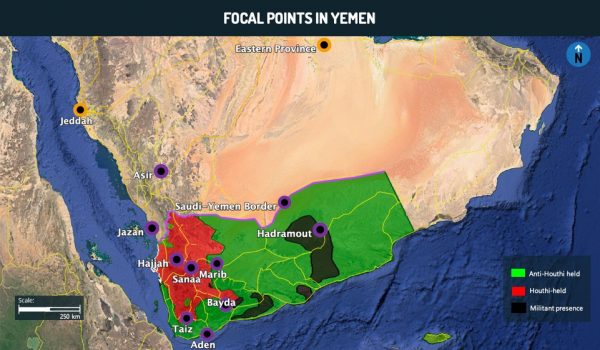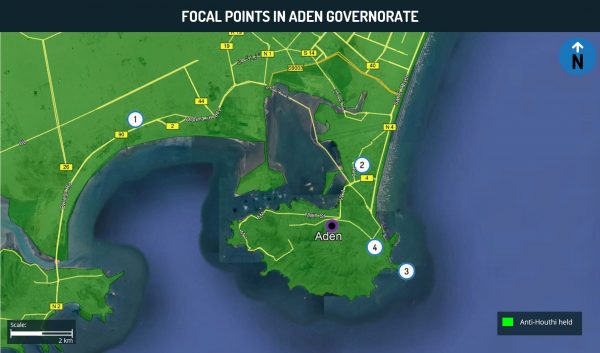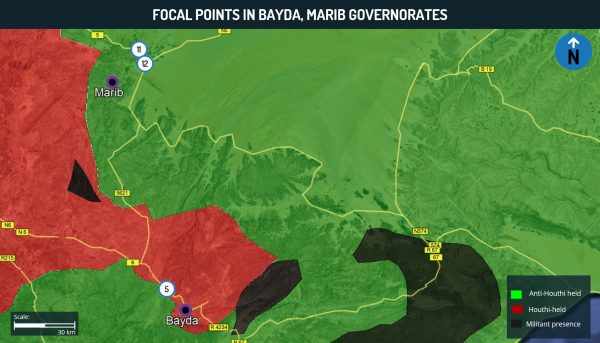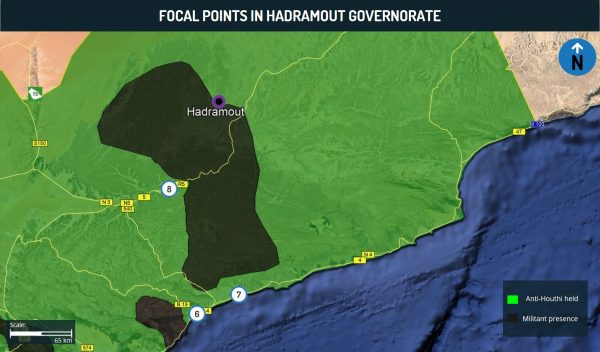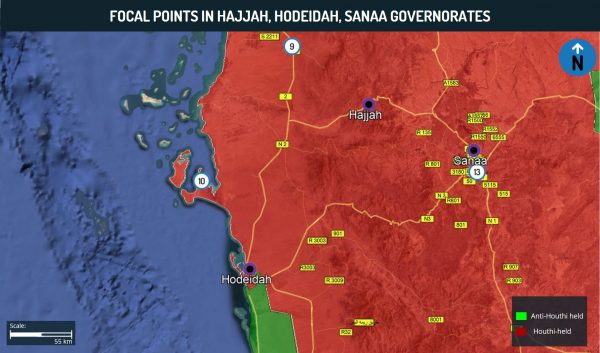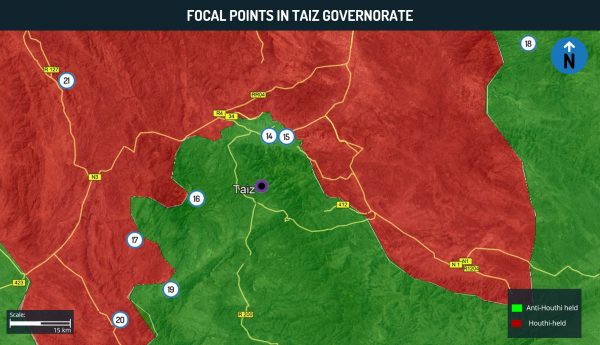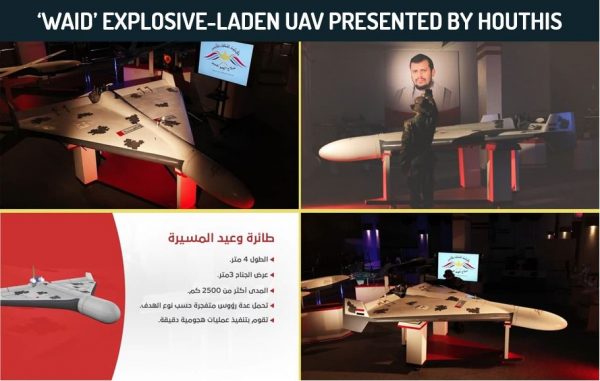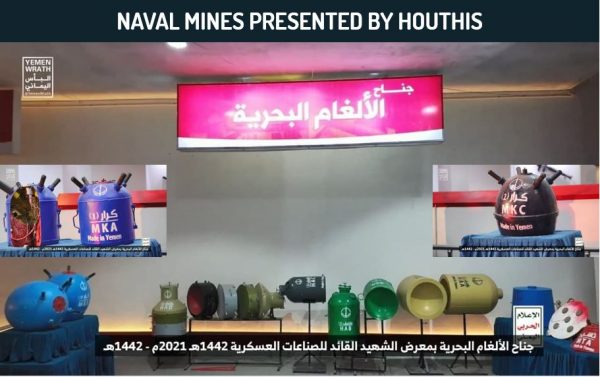17
Mar 2021
12:46 UTC
Yemen SITUATION UPDATE: Pro-STC protesters storm Presidential Palace in Aden on March 16; liable to fuel distrust between STC, Hadi officials
Executive Summary:
- On March 11, several new missiles, unmanned aerial vehicles (UAVs) and naval mines were showcased by the Houthis in an exhibition. This includes the “Zaid” UAV, which is stated to have an operational range of 2500 km, significantly exceeding the proclaimed operational ranges of other explosive-laden UAVs.
- On March 13, the Houthis rejected a US-proposed ceasefire claiming that it represents the “Saudi and international vision”. Although no details regarding the plan have been disclosed, it nevertheless underscores Washington’s resolve to increase its diplomatic engagement in Yemen.
- Anti-Houthi forces have claimed several advances in Taiz Governorate between March 2-16. They will likely focus on gaining as much territory south of the N3 highway that are under Houthi control, between Taiz city and Mocha over the coming days.
- On March 16, pro-STC protesters stormed the Presidential Palace in Aden, which is guarded by STC-linked security forces. This is particularly liable to fuel the distrust between the STC and Hadi officials.
- On March 16, the Saudi-led Coalition intercepted a Houthi-launched explosive-laden vessel near Hodeidah’s al-Salif. This highlights the continued threat to maritime activity in the Red Sea’s international waters.
- Overall, heavy fighting is likely to persist between the Houthi and anti-Houthi forces across Marib, Taiz, and Hajjah governorates over the coming days. Additionally, further socio-economic protests, which have the potential to turn violent, are likely in the southern provinces of Aden and Hadramout.
Current Situation:
Across the country, the following incidents have been reported:
Aden Governorate
| Map # | Date | District/City | Brief Description |
| 1 | March 4 |
Ashaab |
An IED targeted a convoy of the Southern Transitional Council (STC). Two STC leaders reportedly survived the assassination attempt. Several individuals were wounded and killed in the attack. |
| 2 | March 6 | Khormaksar | Protests reportedly broke out to denounce the deterioration of electric services and delay in payment of salaries of employees in the Ministries of Defense and Interior. Protesters reportedly blocked roads with tire fires, following which security forces clashed with demonstrators in several parts of the district. |
| 3, 4 | March 16 | Presidential Palace, Crater | Pro-STC protesters stormed the Presidential Palace as to denounce several socio-economic issues such as corruption, poor basic services, and delayed salaries for public sector workers. According to an unconfirmed report, some of the protesters chanted slogans calling for the expulsion of Hadi officials. Meanwhile, military officers reportedly held a peaceful protest to demand payment of suspended salaries in Crater’s Bank Square. |
Bayda Governorate
| Map # | Date | District/City | Brief Description |
| 5 | March 6 | Dhi Naim | al-Qaeda in the Arabian Peninsula (AQAP) claimed an IED attack against a Houthi vehicle. |
Hadramout Governorate
| Map # | Date | District/City | Brief Description |
| 6 | March 6-8 | al-Mukalla | Locals reportedly cut off roads, burned tires to protest the rise in price of oil derivatives, transportation, and foodstuff. Security forces reportedly dispersed protesters with live bullets. |
| 7 | March 8 | Ash Shihr
|
Locals reportedly blocked roads with tire fires to denounce the price rise in oil derivatives. |
| 8 | March 15 | Seiyun | Clashes were reported between protesters and security forces affiliated with the pro-Hadi “First Military Zone”. At least three demonstrators were injured as a result of security forces firing bullets to disperse protesters. The protest was reportedly being held to denounce the deterioration of basic services and to demand unpaid salaries. Following the incident, the STC spokesperson released a statement condemning the “criminal acts…issued by brutal occupation forces” and announced “full support” for the residents. |
Hajjah Governorate
| Map # | Date | District/City | Brief Description |
| 9 | March 14 | Abs District | The official Houthi news agency reported that the anti-Houthi forces secured control of large areas in north Hajjah governorate, including ten villages in the Abs District as well as areas between Mustaba and Bani Hassan. |
Hodeidah Governorate
| Map # | Date | District/City | Brief Description |
| 10 | March 16 | Near al-Salif | The Saudi-led Coalition reportedly intercepted a Houthi-launched explosive-laden vessel. According to Saudi Arabia’s official news agency, the vessel was intercepted “before carrying out an imminent attack”. |
Marib Governorate
| Map # | Date | District/City | Brief Description |
| 11 | March 11 | Rawda neighborhood | Houthi forces reportedly launched a ballistic missile towards a residential area in Marib. |
| March 11 | Unspecified location | The Saudi-led coalition reportedly destroyed a Houthi “SAM-6” aerial defense system. | |
| 12 | March 14 | Sirwah District | According to the official Hadi news agency, anti-Houthi forces killed 25 Houthi fighters in an attack in the al-Mashjah front. During the attack, the anti-Houthi forces reportedly took control of strategic positions. |
Sanaa Governorate
| Map # | Date | District/City | Brief Description |
| March 8 | Unspecified | The Saudi-led Coalition released video footage of airstrikes, claiming to have targeted Houthi ballistic missile assembly workshops. | |
| 13 | March 10 | Sanaa city | The Houthi official news agency reported on multiple Saudi-led Coalition airstrikes in the city. |
Taiz Governorate
| Map # | Date | District/City | Brief Description |
| 14,15 | March 2 | Taiz city, Wadi Salah | Anti-Houthi forces claimed territorial advances east and west of Taiz city and claimed to “liberate” areas in Wadi Salah. |
| 16 | March 7 | Jabal Habashy District | Anti-Houthi forces reportedly took control of the entire Jabal Habashy District. |
| 17 | March 8 | al-Qashah village, Maqbanah District | According to the official Hadi news agency, anti-Houthi forces took control of several villages, including al-Qashah, from Houthi forces. |
| 18 | March 9-10 | al-Ghaleel, Maqbanah District | Anti-Houthi forces claimed to have “liberated” al-Ghaleel and another village in the district. |
| 19 | March 10 | al-Kadahah, al-Maafer District | The official Hadi government news agency reported that pro-Hadi forces took control of al-Kadahah and managed to open a road between Taiz and Mocha. |
| 20 | March 11 | Jabal Ghubari, al-Wazi’iyah District | Anti-Houthi forces claimed to have taken full control of Jabal Ghubari. |
| 19 | March 14 | al-Kadahah, al-Maafer District | Houthi forces reportedly launched ballistic missiles towards a local school where anti-Houthi forces were gathered. |
| 21 | March 15 | Maqbanah District | Anti-Houthi forces claimed to have taken control of al-Zannabil, al-Haddad, Atef, and Atroosh. |
| 16 | March 16 | Jabal Habashy District | Anti-Houthi forces reportedly liberated the strategic Jabal al-Sarham. |
| 21 | March 16 | Maqbanah District | Anti-Houthi forces claimed to have taken control over areas along the Ramada-Hajda road that links Taiz city with Mokha. |
Asir, Jeddah, Jazan, Eastern Provinces; Saudi Arabia
| Date | District/City | Brief Description |
| March 2-3 | Khamis Mushayt, Abha; Asir Province | The Saudi-led Coalition intercepted two Houthi-launched unmanned aerial vehicles (UAVs). The Houthis claimed to have targeted the King Khalid Air Base in Khamis Mushayt and Abha International Airport using “Qasef-2K” UAVs. |
| March 4 | Jeddah Province | The Houthis claimed to have targeted a Saudi stated-owned oil facility in Jeddah using “Quds-2” missiles. No casualties or material damage were reported at the oil facility. However, flight operations at Jeddah’s King Abdulaziz International Airport were reportedly temporarily suspended as a result of the attack. |
| March 4 | Jazan Province | The Saudi-led Coalition intercepted and destroyed one ballistic missile. |
| March 5 | Khamis Mushayt | Saudi-led Coalition intercepted and destroyed one explosive-laden UAV. |
| March 6 | Khamis Mushayt, Jazan Province | The Saudi-led Coalition claimed to have shot down two Houthi-launched armed UAVs. |
| March 7 | Unspecified | The Saudi-led Coalition announced the interception of ten Houthi-launched armed UAVs. |
| March 7 | Ras Tanura, Dammam, Dhahran; Eastern Province; Asir, Jazan provinces | Saudi-led Coalition spokesperson General Turki al-Malki stated that explosive-laden unmanned aerial vehicles (UAVs) were launched “from the sea” towards a petroleum tank at the Ras Tanura Port and a Saudi state-owned oil facility in Dhahran on March 7. According to a US-based news agency’s report citing an advisor to the Saudi Royal Court, “all indications point to Iran” and that it is not clear whether the attack originated from Iran or Iraq, but it did not come from Yemen. The Houthi military spokesperson, Brigadier General Yahya Saree, claimed responsibility for the attacks targeting the Ras Tanura Port. He added that the Houthis also targeted other military targets in Eastern Province’s Dammam. Saree further stated that several “military sites” in southern Saudi Arabia’s Asir and Jazan provinces were targeted by four “Qasef-2K” UAVs and seven “Badr” missiles. |
| March 8 | Abha | The Houthis stated that they targeted the Abha International Airport with a new ballistic missile that “entered service recently…and hit its target with high accuracy”. |
| March 9 | Khamis Mushayt | The Saudi-led Coalition intercepted a Houthi-launched armed UAV. |
| March 15 | Khamis Mushayt, Abha | The Saudi-led Coalition spokesperson announced the interception of an explosive-laden UAV approximately ten km from Abha International Airport. Meanwhile, the Houthi spokesperson claimed a successful strike on the Abha International Airport and King Khalid Air Base with three “Qasef-2K” UAVs. |
| March 16 | Khamis Mushayt | The Houthi spokesperson claimed a successful strike on the King Khalid Air Base with a “Qasef-2K” UAV. |
General Developments
| Date | Brief Description |
| March 1 | AQAP released a five page document on the Houthi offensives in Marib Governorate. According to the statement, the recent Houthi-perpetrated attacks in Marib were facilitated by an “American green light” following the US’s revocation of the Houthis’ Foreign Terrorist Organization (FTO) designation on February 16. Additionally, the statement accuses the Houthis of being “un-Islamic” and calls for AQAP supporters to have the “patience to fight the Houthis”. |
| March 3 | A senior AQAP member, Qaboos bin Talib, was arrested by anti-Houthi forces near Seiyun in Hadramout. He was wanted for killing a Lieutenant Colonel and two soldiers of the Saudi-led Coalition, along with several civilians, in an IED attack near Hadramout’s Shibam in September 2019. |
| March 7 | The Hadi government restored ties with Qatar. |
| March 11 | The Houthis held their annual arms exhibition, presenting its arsenal of missiles, combat UAVs, and other weapons. The movement revealed several new arms, including the “Samad-4,” “Shihab,” “Khatif,” “Marsad,” and “Waid” combat UAVs. New missiles that were presented in the exhibition include the “Nakal,” the “Qasim” (two variants), “Saeer,” and “Zelzal-3.” The exhibition also showed at least 11 types of naval mines. |
| March 13 | The US Special Envoy for Yemen, Timothy Lenderking, reportedly announced that a ceasefire proposal had been presented to the Houthis. A Houthi spokesperson rejected the plan claiming that it represents the “Saudi and international vision” and does not include lifting the Saudi-imposed blockade. |
Assessments & Forecast:
- The Houthis’ March 11 “Exhibition of Military Productions” comes in the context of its annual exhibitions wherein the Shiite group showcases new and modified weapons that are claimed to be locally-developed within Yemeni territory. Among the several new missiles and combat UAVs that were presented, the “Waid” UAV is one of the most significant. The Houthis claimed that this UAV has a range of over 2500 km, significantly exceeding the proclaimed operational ranges of its other explosive-laden UAVs. Moreover, picture material indicates certain resemblance between the “Waid” UAV and the Iran-made “Shahed-136” suicide UAV, remnants of which were discovered in al-Jawf Governorate in January. The exhibition of new, purportedly more sophisticated long-range weapons by the Houthis also comes amid their marked escalation of cross-border attacks against Saudi Arabia, as highlighted by the score of attacks against the Kingdom reported between March 2-15. In this context, by unveiling advanced weapons, the Houthis likely aim to deter Riyadh and emphasize that the latter’s blockade on Houthi-held territory and continued military support for the anti-Houthi forces in Yemen will continue to result in significant attacks within Saudi territory. FORECAST: Given that multiple weapons, including the naval mines that were recently showcased are perceived to be “Iranian-made”, the Saudi-led Coalition and the Hadi-led government will seek to emphasize Iran’s role in contributing to the instability in Yemen as well as the increased threat it poses to navigation in the Red Sea’s international waters. Nevertheless, as hostilities persist, the Houthis will likely claim future attacks using some of the newly unveiled arms over the coming weeks and months.
- The Houthis’ March 13 rejection of a US-proposed ceasefire comes amid the US President Joe Biden-led administration’s bolstered efforts to foster peace talks between the Houthis and the Hadi-led government. In this context, the US Special Envoy for Yemen, Timothy Lenderking, reportedly met with the Houthis’ chief negotiator in Muscat on February 26. This meeting was part of Lenderking’s visit to the Gulf region, wherein he met with several officials, including from Saudi, “in an effort to push the parties closer to a ceasefire”. Although no details regarding the ceasefire plan have been disclosed, it underscores Washington’s resolve to increase its diplomatic engagement in the conflict in Yemen. However, the Houthis’ rejection of the proposed ceasefire and their discourse on the matter reflects their perception that Washington is promoting the interests of the Saudi-led bloc in Yemen and the overall distrust harbored by the Shiite group towards the US. Moreover, since the Biden-led administration’s inauguration, the Houthis have intensified their cross-border aerial attacks against strategic infrastructure in Saudi Arabia and renewed their offensives to advance towards Marib city. Thus, it is possible that the Shiite group is attempting to both project its ability to pose a threat to Saudi Arabia’s security environment and make further gains in the oil-rich Marib Governorate to strengthen its negotiating power vis-a-vis the anti-Houthi forces. FORECAST: Given that President Biden has stated that Lenderking will “work with the UN envoy and all parties of the conflict to push for a diplomatic resolution”, the US will continue its efforts to promote peace dialogue over the coming months. However, despite such efforts, the Houthis will likely continue to try to increase their military pressure on the Saudi-led Coalition. This will manifest in the form of persistent cross-border attacks towards Saudi Arabia and additional offensives in Marib Governorate over the coming weeks.
- The significant territorial advances made by the anti-Houthi forces in Taiz since the start of March come amid an escalation of hostilities between anti-Houthi and Houthi forces in several fronts in the country, inluding Marib, al-Jawf, and Hajjah. The momentum gained by the anti-Houthi forces in Taiz is partially a result of the reconciliation between the Hadi government and the STC, which allowed for the establishment of a joint government, leading to an overall decrease in military confrontations between the two. This likely allowed the Hadi-led government to allocate forces from southern Yemen to the frontlines in and around Taiz, which bolsters the anti-Houthi momentum. FORECAST: The advances in the districts of Jabal Habashy, Maqbanah, al-Maafer, and al-Wazi’iyah, to the west of Taiz city indicate that the anti-Houthi forces’ primary goal over the coming days and weeks will be to gain as much control over territories south of the N3 highway that are under Houthi control. This would allow anti-Houthi forces to move more easily between Mocha and Taiz city, which would further facilitate their operations. In this context, hostilities in the aforementioned districts in Taiz, including within Taiz city’s surroundings will persist over the coming days and weeks.
- The storming of Aden’s Presidential Palace, also known as the Masheeq Palace by protesters on March 16, as well as in Hadramout’s Seiyun on March 15, comes amid persistent and widespread socio-economic grievances held by large segments of the local population. However, reports have indicated that in both instances, particularly in Aden, some of the protesters were seen carrying STC flags. While the Palace houses Hadi government-linked ministers, including the Prime Minister, it is guarded by STC-linked security forces. In this context, the fact the protesters were deemed as STC supporters and that they were not prevented from entering the government building is liable to fuel the perception that the demonstration was at least partly orchestrated by the STC. This is bolstered by the STC President’s March 16 statement that “Aden avenges our sons in Seiyun”. The latest incident is therefore likely to be perceived by pro-Hadi elements as an effort by the STC to assert its popularity and thereby gain more administrative control in Aden and Hadramout. FORECAST: Overall, this incident is likely to further fuel the mistrust between the STC and the Hadi officials. Furthermore, currently, the government lacks the sufficient resources to address the infrastructural and socio-economic issues in its administered governorates. Additionally, the government’s depleted financial resources are further exacerbated by its ongoing anti-Houthi campaign across several fronts. Thus, further unruly protests will be recorded over the coming weeks and months as the economic situation in Yemen is unlikely to improve in the short term.
- The interception of an explosive-laden boat near Hodeidah’s al-Salif on March 16 by the Saudi-led Coalition comes amid persistent Houthi attempts to conduct attacks in the Red Sea using explosive-laden vessels and naval mines. This represents the second such interception of an explosive-laden vessel by the Coalition in 2021, with a similar event recorded on January 22. The Saudi-led Coalition has long deemed that the Houthis use Hodeidah’s al-Salif and Ras Issa ports to prepare these remote-controlled explosive-laden boats, as they represent two of the closest points to international waters in the Red Sea. The persistent use of such armed vessels highlights the Houthis’ continued efforts to elevate the risk associated with navigating through the Red Sea, as this would have a negative impact on Saudi Arabia’s economy. However, the fact that the Coalition was able to intercept the latest boat close to Yemeni territory, likely before it reached international waters, indicates its heightened vigilance of and ability to gain prior intelligence to mitigate this threat to maritime activity. FORECAST: Overall, the Saudi-led Coalition will likely bolster its military deployment to the Red Sea, particularly off the coast of Hodeidah over the coming weeks.
Recommendations:
- It is advised to avoid all travel to Sanaa and Aden.
- In the event of air strikes, it is advised to take shelter in a basement or on the second story level of a concrete building away from windows and the entrance. If no such areas are available, it is advised to take cover under a sturdy object in the center of the home away from windows; lay on the ground while covering your head with your hands.
- We advise against all travel to outlying areas and overland travel, due to the limited government and security presence, ongoing clashes and airstrikes, as well as the heightened threat of attacks and kidnappings.
- For those operating in or conducting business with oil facilities, it is advised to consult with us for itinerary and contingency support plans.
- Foreigners, particularly Westerners, continuing to operate in Yemen are additionally advised to maintain a low profile, exercise heightened vigilance, and avoid locales frequented by foreign, particularly Western nationals. To mitigate the risk of attacks or abductions, ensure that places of stay are equipped with sufficient perimeter security details, alter travel routes, and avoid disclosing sensitive itinerary information to unknown individuals.
COUNTRY RISK LEVEL
Extreme
AFFECTED AREA
Aden, Bayda, Hadramout, Hajjah, Hodeidah, Marib, Sanaa, Taiz governorates; Yemen
INCIDENT RISK LEVEL
Extreme
STRENGTH OF SOURCE
Credible
Executive Summary:
- On March 11, several new missiles, unmanned aerial vehicles (UAVs) and naval mines were showcased by the Houthis in an exhibition. This includes the “Zaid” UAV, which is stated to have an operational range of 2500 km, significantly exceeding the proclaimed operational ranges of other explosive-laden UAVs.
- On March 13, the Houthis rejected a US-proposed ceasefire claiming that it represents the “Saudi and international vision”. Although no details regarding the plan have been disclosed, it nevertheless underscores Washington’s resolve to increase its diplomatic engagement in Yemen.
- Anti-Houthi forces have claimed several advances in Taiz Governorate between March 2-16. They will likely focus on gaining as much territory south of the N3 highway that are under Houthi control, between Taiz city and Mocha over the coming days.
- On March 16, pro-STC protesters stormed the Presidential Palace in Aden, which is guarded by STC-linked security forces. This is particularly liable to fuel the distrust between the STC and Hadi officials.
- On March 16, the Saudi-led Coalition intercepted a Houthi-launched explosive-laden vessel near Hodeidah’s al-Salif. This highlights the continued threat to maritime activity in the Red Sea’s international waters.
- Overall, heavy fighting is likely to persist between the Houthi and anti-Houthi forces across Marib, Taiz, and Hajjah governorates over the coming days. Additionally, further socio-economic protests, which have the potential to turn violent, are likely in the southern provinces of Aden and Hadramout.
Current Situation:
Across the country, the following incidents have been reported:
Aden Governorate
| Map # | Date | District/City | Brief Description |
| 1 | March 4 |
Ashaab |
An IED targeted a convoy of the Southern Transitional Council (STC). Two STC leaders reportedly survived the assassination attempt. Several individuals were wounded and killed in the attack. |
| 2 | March 6 | Khormaksar | Protests reportedly broke out to denounce the deterioration of electric services and delay in payment of salaries of employees in the Ministries of Defense and Interior. Protesters reportedly blocked roads with tire fires, following which security forces clashed with demonstrators in several parts of the district. |
| 3, 4 | March 16 | Presidential Palace, Crater | Pro-STC protesters stormed the Presidential Palace as to denounce several socio-economic issues such as corruption, poor basic services, and delayed salaries for public sector workers. According to an unconfirmed report, some of the protesters chanted slogans calling for the expulsion of Hadi officials. Meanwhile, military officers reportedly held a peaceful protest to demand payment of suspended salaries in Crater’s Bank Square. |
Bayda Governorate
| Map # | Date | District/City | Brief Description |
| 5 | March 6 | Dhi Naim | al-Qaeda in the Arabian Peninsula (AQAP) claimed an IED attack against a Houthi vehicle. |
Hadramout Governorate
| Map # | Date | District/City | Brief Description |
| 6 | March 6-8 | al-Mukalla | Locals reportedly cut off roads, burned tires to protest the rise in price of oil derivatives, transportation, and foodstuff. Security forces reportedly dispersed protesters with live bullets. |
| 7 | March 8 | Ash Shihr
|
Locals reportedly blocked roads with tire fires to denounce the price rise in oil derivatives. |
| 8 | March 15 | Seiyun | Clashes were reported between protesters and security forces affiliated with the pro-Hadi “First Military Zone”. At least three demonstrators were injured as a result of security forces firing bullets to disperse protesters. The protest was reportedly being held to denounce the deterioration of basic services and to demand unpaid salaries. Following the incident, the STC spokesperson released a statement condemning the “criminal acts…issued by brutal occupation forces” and announced “full support” for the residents. |
Hajjah Governorate
| Map # | Date | District/City | Brief Description |
| 9 | March 14 | Abs District | The official Houthi news agency reported that the anti-Houthi forces secured control of large areas in north Hajjah governorate, including ten villages in the Abs District as well as areas between Mustaba and Bani Hassan. |
Hodeidah Governorate
| Map # | Date | District/City | Brief Description |
| 10 | March 16 | Near al-Salif | The Saudi-led Coalition reportedly intercepted a Houthi-launched explosive-laden vessel. According to Saudi Arabia’s official news agency, the vessel was intercepted “before carrying out an imminent attack”. |
Marib Governorate
| Map # | Date | District/City | Brief Description |
| 11 | March 11 | Rawda neighborhood | Houthi forces reportedly launched a ballistic missile towards a residential area in Marib. |
| March 11 | Unspecified location | The Saudi-led coalition reportedly destroyed a Houthi “SAM-6” aerial defense system. | |
| 12 | March 14 | Sirwah District | According to the official Hadi news agency, anti-Houthi forces killed 25 Houthi fighters in an attack in the al-Mashjah front. During the attack, the anti-Houthi forces reportedly took control of strategic positions. |
Sanaa Governorate
| Map # | Date | District/City | Brief Description |
| March 8 | Unspecified | The Saudi-led Coalition released video footage of airstrikes, claiming to have targeted Houthi ballistic missile assembly workshops. | |
| 13 | March 10 | Sanaa city | The Houthi official news agency reported on multiple Saudi-led Coalition airstrikes in the city. |
Taiz Governorate
| Map # | Date | District/City | Brief Description |
| 14,15 | March 2 | Taiz city, Wadi Salah | Anti-Houthi forces claimed territorial advances east and west of Taiz city and claimed to “liberate” areas in Wadi Salah. |
| 16 | March 7 | Jabal Habashy District | Anti-Houthi forces reportedly took control of the entire Jabal Habashy District. |
| 17 | March 8 | al-Qashah village, Maqbanah District | According to the official Hadi news agency, anti-Houthi forces took control of several villages, including al-Qashah, from Houthi forces. |
| 18 | March 9-10 | al-Ghaleel, Maqbanah District | Anti-Houthi forces claimed to have “liberated” al-Ghaleel and another village in the district. |
| 19 | March 10 | al-Kadahah, al-Maafer District | The official Hadi government news agency reported that pro-Hadi forces took control of al-Kadahah and managed to open a road between Taiz and Mocha. |
| 20 | March 11 | Jabal Ghubari, al-Wazi’iyah District | Anti-Houthi forces claimed to have taken full control of Jabal Ghubari. |
| 19 | March 14 | al-Kadahah, al-Maafer District | Houthi forces reportedly launched ballistic missiles towards a local school where anti-Houthi forces were gathered. |
| 21 | March 15 | Maqbanah District | Anti-Houthi forces claimed to have taken control of al-Zannabil, al-Haddad, Atef, and Atroosh. |
| 16 | March 16 | Jabal Habashy District | Anti-Houthi forces reportedly liberated the strategic Jabal al-Sarham. |
| 21 | March 16 | Maqbanah District | Anti-Houthi forces claimed to have taken control over areas along the Ramada-Hajda road that links Taiz city with Mokha. |
Asir, Jeddah, Jazan, Eastern Provinces; Saudi Arabia
| Date | District/City | Brief Description |
| March 2-3 | Khamis Mushayt, Abha; Asir Province | The Saudi-led Coalition intercepted two Houthi-launched unmanned aerial vehicles (UAVs). The Houthis claimed to have targeted the King Khalid Air Base in Khamis Mushayt and Abha International Airport using “Qasef-2K” UAVs. |
| March 4 | Jeddah Province | The Houthis claimed to have targeted a Saudi stated-owned oil facility in Jeddah using “Quds-2” missiles. No casualties or material damage were reported at the oil facility. However, flight operations at Jeddah’s King Abdulaziz International Airport were reportedly temporarily suspended as a result of the attack. |
| March 4 | Jazan Province | The Saudi-led Coalition intercepted and destroyed one ballistic missile. |
| March 5 | Khamis Mushayt | Saudi-led Coalition intercepted and destroyed one explosive-laden UAV. |
| March 6 | Khamis Mushayt, Jazan Province | The Saudi-led Coalition claimed to have shot down two Houthi-launched armed UAVs. |
| March 7 | Unspecified | The Saudi-led Coalition announced the interception of ten Houthi-launched armed UAVs. |
| March 7 | Ras Tanura, Dammam, Dhahran; Eastern Province; Asir, Jazan provinces | Saudi-led Coalition spokesperson General Turki al-Malki stated that explosive-laden unmanned aerial vehicles (UAVs) were launched “from the sea” towards a petroleum tank at the Ras Tanura Port and a Saudi state-owned oil facility in Dhahran on March 7. According to a US-based news agency’s report citing an advisor to the Saudi Royal Court, “all indications point to Iran” and that it is not clear whether the attack originated from Iran or Iraq, but it did not come from Yemen. The Houthi military spokesperson, Brigadier General Yahya Saree, claimed responsibility for the attacks targeting the Ras Tanura Port. He added that the Houthis also targeted other military targets in Eastern Province’s Dammam. Saree further stated that several “military sites” in southern Saudi Arabia’s Asir and Jazan provinces were targeted by four “Qasef-2K” UAVs and seven “Badr” missiles. |
| March 8 | Abha | The Houthis stated that they targeted the Abha International Airport with a new ballistic missile that “entered service recently…and hit its target with high accuracy”. |
| March 9 | Khamis Mushayt | The Saudi-led Coalition intercepted a Houthi-launched armed UAV. |
| March 15 | Khamis Mushayt, Abha | The Saudi-led Coalition spokesperson announced the interception of an explosive-laden UAV approximately ten km from Abha International Airport. Meanwhile, the Houthi spokesperson claimed a successful strike on the Abha International Airport and King Khalid Air Base with three “Qasef-2K” UAVs. |
| March 16 | Khamis Mushayt | The Houthi spokesperson claimed a successful strike on the King Khalid Air Base with a “Qasef-2K” UAV. |
General Developments
| Date | Brief Description |
| March 1 | AQAP released a five page document on the Houthi offensives in Marib Governorate. According to the statement, the recent Houthi-perpetrated attacks in Marib were facilitated by an “American green light” following the US’s revocation of the Houthis’ Foreign Terrorist Organization (FTO) designation on February 16. Additionally, the statement accuses the Houthis of being “un-Islamic” and calls for AQAP supporters to have the “patience to fight the Houthis”. |
| March 3 | A senior AQAP member, Qaboos bin Talib, was arrested by anti-Houthi forces near Seiyun in Hadramout. He was wanted for killing a Lieutenant Colonel and two soldiers of the Saudi-led Coalition, along with several civilians, in an IED attack near Hadramout’s Shibam in September 2019. |
| March 7 | The Hadi government restored ties with Qatar. |
| March 11 | The Houthis held their annual arms exhibition, presenting its arsenal of missiles, combat UAVs, and other weapons. The movement revealed several new arms, including the “Samad-4,” “Shihab,” “Khatif,” “Marsad,” and “Waid” combat UAVs. New missiles that were presented in the exhibition include the “Nakal,” the “Qasim” (two variants), “Saeer,” and “Zelzal-3.” The exhibition also showed at least 11 types of naval mines. |
| March 13 | The US Special Envoy for Yemen, Timothy Lenderking, reportedly announced that a ceasefire proposal had been presented to the Houthis. A Houthi spokesperson rejected the plan claiming that it represents the “Saudi and international vision” and does not include lifting the Saudi-imposed blockade. |
Assessments & Forecast:
- The Houthis’ March 11 “Exhibition of Military Productions” comes in the context of its annual exhibitions wherein the Shiite group showcases new and modified weapons that are claimed to be locally-developed within Yemeni territory. Among the several new missiles and combat UAVs that were presented, the “Waid” UAV is one of the most significant. The Houthis claimed that this UAV has a range of over 2500 km, significantly exceeding the proclaimed operational ranges of its other explosive-laden UAVs. Moreover, picture material indicates certain resemblance between the “Waid” UAV and the Iran-made “Shahed-136” suicide UAV, remnants of which were discovered in al-Jawf Governorate in January. The exhibition of new, purportedly more sophisticated long-range weapons by the Houthis also comes amid their marked escalation of cross-border attacks against Saudi Arabia, as highlighted by the score of attacks against the Kingdom reported between March 2-15. In this context, by unveiling advanced weapons, the Houthis likely aim to deter Riyadh and emphasize that the latter’s blockade on Houthi-held territory and continued military support for the anti-Houthi forces in Yemen will continue to result in significant attacks within Saudi territory. FORECAST: Given that multiple weapons, including the naval mines that were recently showcased are perceived to be “Iranian-made”, the Saudi-led Coalition and the Hadi-led government will seek to emphasize Iran’s role in contributing to the instability in Yemen as well as the increased threat it poses to navigation in the Red Sea’s international waters. Nevertheless, as hostilities persist, the Houthis will likely claim future attacks using some of the newly unveiled arms over the coming weeks and months.
- The Houthis’ March 13 rejection of a US-proposed ceasefire comes amid the US President Joe Biden-led administration’s bolstered efforts to foster peace talks between the Houthis and the Hadi-led government. In this context, the US Special Envoy for Yemen, Timothy Lenderking, reportedly met with the Houthis’ chief negotiator in Muscat on February 26. This meeting was part of Lenderking’s visit to the Gulf region, wherein he met with several officials, including from Saudi, “in an effort to push the parties closer to a ceasefire”. Although no details regarding the ceasefire plan have been disclosed, it underscores Washington’s resolve to increase its diplomatic engagement in the conflict in Yemen. However, the Houthis’ rejection of the proposed ceasefire and their discourse on the matter reflects their perception that Washington is promoting the interests of the Saudi-led bloc in Yemen and the overall distrust harbored by the Shiite group towards the US. Moreover, since the Biden-led administration’s inauguration, the Houthis have intensified their cross-border aerial attacks against strategic infrastructure in Saudi Arabia and renewed their offensives to advance towards Marib city. Thus, it is possible that the Shiite group is attempting to both project its ability to pose a threat to Saudi Arabia’s security environment and make further gains in the oil-rich Marib Governorate to strengthen its negotiating power vis-a-vis the anti-Houthi forces. FORECAST: Given that President Biden has stated that Lenderking will “work with the UN envoy and all parties of the conflict to push for a diplomatic resolution”, the US will continue its efforts to promote peace dialogue over the coming months. However, despite such efforts, the Houthis will likely continue to try to increase their military pressure on the Saudi-led Coalition. This will manifest in the form of persistent cross-border attacks towards Saudi Arabia and additional offensives in Marib Governorate over the coming weeks.
- The significant territorial advances made by the anti-Houthi forces in Taiz since the start of March come amid an escalation of hostilities between anti-Houthi and Houthi forces in several fronts in the country, inluding Marib, al-Jawf, and Hajjah. The momentum gained by the anti-Houthi forces in Taiz is partially a result of the reconciliation between the Hadi government and the STC, which allowed for the establishment of a joint government, leading to an overall decrease in military confrontations between the two. This likely allowed the Hadi-led government to allocate forces from southern Yemen to the frontlines in and around Taiz, which bolsters the anti-Houthi momentum. FORECAST: The advances in the districts of Jabal Habashy, Maqbanah, al-Maafer, and al-Wazi’iyah, to the west of Taiz city indicate that the anti-Houthi forces’ primary goal over the coming days and weeks will be to gain as much control over territories south of the N3 highway that are under Houthi control. This would allow anti-Houthi forces to move more easily between Mocha and Taiz city, which would further facilitate their operations. In this context, hostilities in the aforementioned districts in Taiz, including within Taiz city’s surroundings will persist over the coming days and weeks.
- The storming of Aden’s Presidential Palace, also known as the Masheeq Palace by protesters on March 16, as well as in Hadramout’s Seiyun on March 15, comes amid persistent and widespread socio-economic grievances held by large segments of the local population. However, reports have indicated that in both instances, particularly in Aden, some of the protesters were seen carrying STC flags. While the Palace houses Hadi government-linked ministers, including the Prime Minister, it is guarded by STC-linked security forces. In this context, the fact the protesters were deemed as STC supporters and that they were not prevented from entering the government building is liable to fuel the perception that the demonstration was at least partly orchestrated by the STC. This is bolstered by the STC President’s March 16 statement that “Aden avenges our sons in Seiyun”. The latest incident is therefore likely to be perceived by pro-Hadi elements as an effort by the STC to assert its popularity and thereby gain more administrative control in Aden and Hadramout. FORECAST: Overall, this incident is likely to further fuel the mistrust between the STC and the Hadi officials. Furthermore, currently, the government lacks the sufficient resources to address the infrastructural and socio-economic issues in its administered governorates. Additionally, the government’s depleted financial resources are further exacerbated by its ongoing anti-Houthi campaign across several fronts. Thus, further unruly protests will be recorded over the coming weeks and months as the economic situation in Yemen is unlikely to improve in the short term.
- The interception of an explosive-laden boat near Hodeidah’s al-Salif on March 16 by the Saudi-led Coalition comes amid persistent Houthi attempts to conduct attacks in the Red Sea using explosive-laden vessels and naval mines. This represents the second such interception of an explosive-laden vessel by the Coalition in 2021, with a similar event recorded on January 22. The Saudi-led Coalition has long deemed that the Houthis use Hodeidah’s al-Salif and Ras Issa ports to prepare these remote-controlled explosive-laden boats, as they represent two of the closest points to international waters in the Red Sea. The persistent use of such armed vessels highlights the Houthis’ continued efforts to elevate the risk associated with navigating through the Red Sea, as this would have a negative impact on Saudi Arabia’s economy. However, the fact that the Coalition was able to intercept the latest boat close to Yemeni territory, likely before it reached international waters, indicates its heightened vigilance of and ability to gain prior intelligence to mitigate this threat to maritime activity. FORECAST: Overall, the Saudi-led Coalition will likely bolster its military deployment to the Red Sea, particularly off the coast of Hodeidah over the coming weeks.
Recommendations:
- It is advised to avoid all travel to Sanaa and Aden.
- In the event of air strikes, it is advised to take shelter in a basement or on the second story level of a concrete building away from windows and the entrance. If no such areas are available, it is advised to take cover under a sturdy object in the center of the home away from windows; lay on the ground while covering your head with your hands.
- We advise against all travel to outlying areas and overland travel, due to the limited government and security presence, ongoing clashes and airstrikes, as well as the heightened threat of attacks and kidnappings.
- For those operating in or conducting business with oil facilities, it is advised to consult with us for itinerary and contingency support plans.
- Foreigners, particularly Westerners, continuing to operate in Yemen are additionally advised to maintain a low profile, exercise heightened vigilance, and avoid locales frequented by foreign, particularly Western nationals. To mitigate the risk of attacks or abductions, ensure that places of stay are equipped with sufficient perimeter security details, alter travel routes, and avoid disclosing sensitive itinerary information to unknown individuals.


